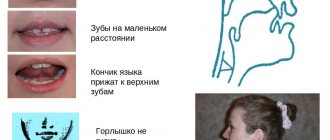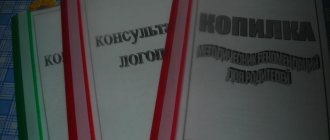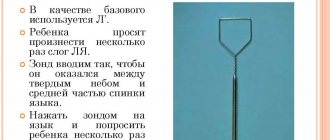Correct articulation and pronunciation disorders
Correct articulation C is similar to articulation I. Only the teeth are closed, the tongue is behind them and is located below, an air stream passes through its central part. The exhalation is strong and cold. If the organs of articulation take the wrong position, then a distortion of sound pronunciation results. Therefore, when diagnosing, a speech therapist pays attention to the state of articulation and speech breathing.
Incorrect pronunciation of a whistling group is called sigmatism, and their replacement in speech with others is called parasigmatism.
Main types of violation:
- The child has no sound in speech.
- Interdental - when a child says C, the tongue is between the teeth. A whistling sound appears with an overtone as in the word “that”. With this violation, the air stream is not cold, but warm.
- Lateral - during pronunciation, the tongue takes a side position or rises. The air stream is directed to the side, one corner of the lips may be lowered, and the gap between the teeth becomes larger.
- Nasal - with this type of sigmatism, a nasal sound is produced, more like an X. The articulation is as follows: the lips are not stretched in a smiling position, the tongue is moved deeper into the mouth, and the child exhales through the nose, which gives the sound a nasal tone.
Most often in speech, whistling sounds are replaced by hissing ones, and there may be voicing. In such cases, great attention should be paid to the differentiation stage.
Causes
Predisposing factors to incorrect pronunciation of “R” may be the following:
- Short hyoid frenulum. It is able to limit the upward movement of the tip and front of the back of the tongue.
- Insufficient air pressure when pronouncing this sound.
- Limited mobility of the tongue muscles, which leads to the inability to take the correct articulatory position and perform voluntary movements of the tongue.
Short frenulum of the tongue
If the child has a short frenulum that does not require cutting, then work must be done to stretch it. It includes massage and articulation exercises. It is quite possible to perform a massage at home. You need to grab the frenulum with your thumb and forefinger at the very bottom under the tongue and rub it with pressing movements. It is necessary to knead the bridle along its entire length, trying to stretch it. But be careful not to damage it. Do several of these movements. After some time, you will see that the frenulum has increased.
As an example of articulation exercises for stretching the frenulum, we offer you the following:
- “Reach your tongue to your nose.” You need to smile, open your mouth. Raise the wide tip of the tongue up to the nose and then lower it to the upper lip. In this case, the tongue should not narrow, and the jaws should remain motionless.
- “Reach your chin.” Smile and open your mouth. Try to reach your chin with your wide tongue. Make sure that the jaws are motionless.
- "Painter". Smile and open your mouth. Use the tip of your tongue to stroke the roof of your mouth from your teeth to your throat. The lower jaw is motionless.
There are rules that parents need to remember so as not to harm their child during exercises:
- You need to open your mouth as wide as possible, but at the same time the child must reach the alveoli.
- All exercises should be performed slowly, close to the limit of what is possible. Remember, during exercises the tongue may get tired, the frenulum may begin to hurt, so it is necessary to give the child a rest.
Insufficient air flow force
As mentioned earlier, the reason for the violation of the pronunciation of the sound “P” may be insufficient strength of the air stream. We offer you exercises aimed at increasing it:
"Blow up the balloons." Inflate two cheeks and hold the air in them.
Weak tongue muscles
Strengthening the muscles of the tongue and the development of articulatory motor skills are facilitated by exercises in which the tongue rises up to the palate. Here are some of them:
- “Horse” - click your tongue, stretching the hyoid ligament.
- “Turkey” - you need to quickly touch your upper lip with the tip of your tongue and accompany these movements with sounds similar to bl-bl-bl
- “Accordion” - pull the tongue to the palate. Hold it in this position while alternately lowering and raising the lower jaw.
Reasons for violations
One of the reasons for the appearance of sigmatism is a violation of articulation. It may be due to anatomical features, for example, malocclusion. Then you need to visit an orthodontist. Or it could be the presence of adenoids that need to be removed.
Violations of sound pronunciation C can be caused by the following features of the articulatory apparatus:
- weak muscle tone of the tongue;
- tremor of the tip of the tongue.
The absence or impairment of pronunciation C may be a manifestation of dyslalia (simple and complex forms) or be part of more complex speech disorders: dysarthria, rhinolalia, alalia. Based on the cause of the violations, the speech therapist draws up a plan for corrective work.
How to teach a child to say the letter R? Why do you need a doctor's help?
If you and your child’s attempts to master the letter “r” have failed, I recommend contacting a speech therapist...
The doctor will be able to identify the cause , since the letter “r” can be pronounced in different ways... Some kids replace “r” with “l”, there are those who simply “swallow” it, or if the letter is in the middle of a word, the baby pronounces it , but when at the end of a word, then no (it’s more difficult for him to do this).
The letter “r” can also be pronounced using the larynx , but in this case, it is worth rushing to solve this problem...
If the airways and articulatory apparatus are poorly developed, pronunciation may also be incorrect. In such cases, the doctor will be able to offer an individual technique for the child, taking into account the child’s pronunciation characteristics. And the letter “r” will “give up” under the “pressure” of the specialist.
You should not be negligent about this, since there are cases when incorrect pronunciation of the letter “r” causes pathology - Dysarthria, this is when the brain is affected.
Speech therapy diagnostics
The speech therapist looks at the state of the articulatory apparatus: the state of the bite, the muscle tone of the tongue and lips. To do this, he asks the preschooler to perform exercises to maintain a certain position and dynamic tasks. In addition, the speech therapist evaluates speech breathing: watches how the baby inhales and exhales, asks to play the pipe.
To diagnose sound pronunciation, a specialist selects speech material in which C is at the beginning, middle and end of the word. In this case, there should be no mixed sounds in the words. This is the Z, C and hissing group. First, the speech therapist asks you to say the sound in isolation, then in syllables, words, phrasal speech and sentences. Then he asks the child to write a story or describe what is drawn in the picture and pays attention to how S sounds in ordinary speech.
Then they make a diagnosis of phonemic processes. The speech therapist names the sounds, and the child must do a certain action when he hears the right one. Gradually, the specialist complicates the speech material, naming syllables and words. Then the patient is asked to name the desired word from a pair of paronyms and select words with the desired sound from the list.
Based on diagnostic data, the speech therapist draws up a plan of correctional work. If the speech disorder is complex, then the child needs to be provided with comprehensive assistance. It includes the joint work of a speech therapist, neurologist, and defectologist.
Tips for parents
Quite often, the child pronounces the correct sounds during classes with speech therapists and teachers. But, returning home, he loses control of himself. This behavior is allowed in the first steps of correction, since the child learns to control himself gradually. However, parents should be persistent. They can help form auditory attention faster.
Many adults communicate little with children, limiting themselves to only short remarks, for example, “go eat,” “wash your hands,” and so on. To form the correct sound pronunciation, you need to talk more with the child. Voice any situations, accompanying them with visual contact. For correct pronunciation of sounds, the baby must see the articulation of the parents. Therefore, try to speak clearly, clearly and with intonation. When communicating with your child, avoid complex sentences. Too much information will not allow him to focus on sounds. At the same time, children often acquire the bad habit of listening to adults mechanically. This may interfere with correction, since the child will transfer this behavior to the teacher’s office.
Read more books to your baby. This will give him the opportunity not only to remember the correct sounds, but will also significantly expand his horizons. Fairy tales, poems, ditties and stories can be repeated several times. Children perceive better information that is already familiar to them. To learn how to reproduce sounds correctly, you can also role-play scenes and use various objects and gestures. Children like this form of activity and they do not resist. Watch how your baby pronounces sounds, whether he pronounces them clearly or tries to swallow them. Don't rush him while reading poetry. Let him say every sound.
The development of fine motor skills also has a good effect on the formation of correct speech. You will be surprised that modeling from plasticine or drawing will help your baby pronounce sounds well. This will also have a positive impact on the development of written speech in the future. The child must be able to fasten buttons, tie shoelaces, knots and bows. This also affects the correct pronunciation of sounds due to the development of hand-eye coordination.
Preparatory stage
You can put C on your own at home if you do special exercises. Preparation for the performance consists of articulatory gymnastics and the formation of correct speech breathing. If the tongue's muscle tone is impaired, then massage is necessary. At the pharmacy you can purchase a special kit for speech therapy massage.
A child can do self-massage of the tongue:
- “Naughty tongue” - a wide tongue on the lower lip. The child says “pyapapapya”, but does not remove his tongue.
- The position of the tongue is similar, only now the child should bite it lightly - the tip and the middle.
In addition to this massage, at the preparatory stage they do a set of articulation exercises. The main position for the lips in all tasks is a smile, and the tongue occupies a lower position. Your task is to teach how to make your tongue wide and relaxed and hold it in this position below your teeth. A good exercise is “Mountain”: the tip of the tongue rests on the lower teeth, and its middle and side edges move forward - it turns out to be a hill.
In addition to gymnastics for the articulation apparatus, you need to develop a strong exhalation.
- "Who will score a goal." To do this you will need two small pieces of cotton wool and objects that will serve as gates. Stretch your lips with a straw, inhale through your nose and, as you exhale, blow out the cotton ball. When performing this exercise, the child should, without puffing out his cheeks, move the cotton wool in one exhalation.
- Do the same thing, only now your lips are in a smiling position, and your wide tongue is on your lower lip. The child blows off the cotton wool, pronouncing an extended F.
The preparatory stage is needed to form the basis for staging the correct pronunciation of S. Also, exercises for whistling are the basis for staging other groups of sounds. That is why, if the sound pronunciation of several groups is impaired, work begins with the whistlers.
Staging sound without a speech therapist
How to teach to say the letter R? To teach a child how to correctly say the letter P, you should follow the following rules for organizing exercises, articulatory gymnastics, as well as the development of speech breathing:
- Until the age of 2, there is no need to require your baby to pronounce complex sounds, since children first learn to pronounce simple ones. It is best to prepare the speech apparatus with the help of easy tasks.
- Classes should begin when the child reaches 5 years of age. They can coincide with the period when he learns to read, this will expand the range of activities.
- The most effective methods are carried out in a playful way, since young children have no interest in ordinary tasks.
- Parents need to follow the full course to the end. Otherwise, their child may not fully master the skill. For example, he will not learn to pronounce a soft or hard sound.
- It is advisable to perform the training daily according to the schedule, since long breaks can nullify all the success achieved. Only regular repetition will lead to automatic correct pronunciation of sounds.
It should be remembered that every parent can correct speech defects, but to do this you need to familiarize yourself with the full course of speech gymnastics. Articulatory gymnastics for producing the sound P will help solve both problems:
- Prepares the speech organs to pronounce letters.
- With its help, the tongue, lips, and cheeks “warm up” before training.
It is much more convenient to perform gymnastics for the speech apparatus in front of a mirror or so that an adult is imitated. Training should be done daily, but not for long, to avoid fatigue. For speech gymnastics, the game form is preferable.
A good exhalation is a fundamental component of a successful result. Soap bubbles or a small ping-pong ball will help you develop exhalation; you need to blow it into the gate with a strong and precise exhalation. These and other fun trainings help organize the correct air flow. The following are exercises for producing the sound R:
Take note of simple and accessible exercises for developing good exhalation - playing with soap bubbles
- "Turkey". With your mouth slightly open, reaching for the lip located on top, move the edge of the tongue back and forth along it. Without moving away from your lip, try to pronounce “bl – bl – bl – bl – bl”, increasing the tempo.
- "Painter". The task is to “paint” with the tongue the entire inner surface of the mouth (including the cheeks, palate, teeth). Do this with back and forth movements.
- "Horse". The idea is to flick your tongue across the roof of your mouth, imitating the clicking sound of a horse.
- "Mushroom". This task is considered a continuation of “The Horse”. Stop the tongue, “glue” it to the sky and hold in this position for 10 seconds. The taut hyoid frenulum is considered a “mushroom stalk.”
- "Motor". The name of the main task is based on the similar sound of R with motor start. “Motor” is a continuation of “Mushroom”. Place your finger under the tongue, pressed to the upper palate. It is recommended to use the child's finger or a regular cotton swab. The baby needs to exhale strongly and say a long “dddddd” at the same time. At the same time, you should make oscillatory movements from side to side with the child’s finger or a cotton swab. The tongue begins to vibrate and make a “rrrrrr” sound. This means that the “engine” has started.
With easy implementation of speech therapy exercises for establishing the sound R in children, you can move on to starting the letter itself. You can also watch video lessons for setting the sound P to clearly see how the training takes place.
Staging methods
At home, adults can independently pronounce S. You can use the articulation I as a support. Ask the child to pronounce I for a long time several times, and then perform articulation and breathing exercises. There are two ways to set C:
- Ask your child to smile as if pronouncing I. The teeth should be together and the tongue should be behind them. Then the baby blows on the cotton wool in front of him. You may hear a slight whistle. The stronger the child exhales, the clearer the sound will be.
- Mechanical method - to perform it you will need a cotton swab. The starting position is the same as for articulation I. Only place the tip of a cotton swab in the middle of the tongue and press lightly to create a groove. The child blows on his tongue - you will hear S. Be sure to bring the back of your hand up: as you exhale, the stream turns out to be cold, strong and narrow.
The mechanical method can be used at the stages of automating isolated pronunciation and practicing sounds in syllables. When the articulation organs “remember” the desired position, the cotton swab can be removed.
Many parents ask: “How to teach a child to pronounce the letter C?” Sounds are introduced and letters are studied in literacy classes. A person hears and pronounces sounds, and reads and sees letters. This difference needs to be explained to the child so that it is easier for him to learn the sound analysis of the word.
The child does not pronounce letters, advice from a speech therapist
Problems in pronouncing certain sounds in children are quite common. The baby can chatter incessantly, but some letters still cannot be given to him. In this article, dear parents, we will consider the nature of this deviation and figure out how to teach a child to pronounce letters.
Causes of speech impairment in a child
The root cause of incorrect pronunciation is often the “lisping” characteristic of all parents, a change in voice when communicating with the toddler. Over time, the baby gets used to it and inherits it. To avoid such a situation, it is necessary to speak to the child in a clear and understandable language, and immediately correct deficiencies in his speech - this will become more difficult with age. It happens that parents do not pay enough attention to their little one’s ability to express thoughts, he is very small - this will pass with time. This is a huge misconception! It is necessary to participate in this process from a very early age, to be attentive to everything that children say or try to say. If you notice that your child communicates only with gestures or that only you understand him and translate for others, immediately begin active work on this problem.
How to teach a child to pronounce sounds?
The most effective way is articulation gymnastics, which you can practice at home. This is a set of simple and interesting exercises that will help in developing correct pronunciation. True, it requires time and patience on the part of parents. Remember that you need to spend at least 15 minutes a day on exercises; if your child is tired, take a short break with him, do not overexert him. It is also necessary to develop the child’s fine motor skills: sorting out details, beads, buttons, while reciting various tongue twisters or rhymes with him, which also contribute to the development of the speech apparatus. These methods are effective only when the baby is fully concentrated: turn off the TV, put away the toys, and you can also put a small mirror in front of his face so that he can see how his mouth works. Important: do not be angry with your child if something doesn’t work out for him.
What exercises will help your baby pronounce sounds?
To begin, prepare cards with your favorite animals, cartoon characters, or goodies containing problematic letters depicted and labeled, so you can determine where to focus. It is also necessary to warm up your lips and tongue; a set of special exercises will help you with this. For example:
“Pancake” - the baby puts his tongue outstretched on his lower lip and holds it for at least 10 seconds.
“Cup” - you need to straighten your tongue on your lower lip, while lifting its tip so that a cup is formed.
“Chatterer” - connected with the previous exercise, the child lowers and raises our “cup” up and down.
“Elephants” - the child must alternately make a wide “tube” with his lips (depicting the letter O), then a narrow one (the letter U).
The last one, but so loved by children, is “Horse” - the child needs to click his tongue like a horse’s hooves.
Make your lesson more interactive with interesting stories. Afterwards, when you have warmed up well and had fun, you can proceed directly to gymnastics.
Let's start with the letter “Ш” , as the most difficult to pronounce along with all the sibilants. Speech therapy exercises should begin with separate pronunciation of sounds. Next, combine with a sound that the child can pronounce. A simple example of the sound “T”: the child says “Ts-s-s”, then ask him to hide his tongue behind his teeth and say it again - the result will be the sound “Sh”. You can also do the exercise “Frozen Hands” - rub your palms together, saying shhhh. Play associations: imitate the sound of the wind, the hissing of a cat or the sound of a descending ball. Correct pronunciation can be adjusted using the sound “C”; ask the child to pronounce it while lifting the tip of the tongue with a spoon to create a gap between the tongue and the palate. Afterwards, let him do this exercise himself.
“Silence” will help in mastering the sound “S”; it consists in the fact that the baby needs to stretch “t-sss” into this letter.
The voiced brother is the sound “Z” , to teach the child to pronounce it, explain that you need to say “S” loudly, show the baby how the muscles of the neck tense when he pronounces the voiced letters.
But the letter “C” can be mastered by using the already familiar “Silence”, only using the sound “ts-ts-ts”.
For the correct “H”, the baby needs to say “t-t-t-t”, and at this time you need to lightly press his cheeks with your fingers.
The most common problem is the letters “P” and “L” ; to solve it, it is necessary to teach the child not to replace a complex breakthrough with a soft and easy one. To help your tiger cub learn to growl, try doing a number of exercises with him, such as:
“Machine” - you need to put your thumb under your tongue and move it from cheek to cheek and try to growl.
“Brushing your teeth” - ask your child to smile widely, running his tongue along the inside of his upper teeth; It is important that the lower jaw does not move.
“Naughty” - let the baby misbehave by sticking out his tongue, wagging it up and down, he should try to growl. I think he will appreciate the opportunity to play pranks with impunity.
After gymnastics classes, you will need prepared cards, and also arm yourself with funny tongue twisters containing problematic sounds. Talk them through with your child and the result of your efforts will not keep you waiting. Remember that you must arouse interest in these activities without boring your child!
When should you contact a speech therapist?
If for a long time you do not notice progress in speaking, you need the help of a specialist. Since the inability to pronounce some sounds is caused physiologically: malocclusion, hearing loss, frenulum pathology, and so on. In this case, the doctor may prescribe exercises or surgery that your child needs based on the difficulties encountered. A speech therapist, in turn, can understand the nature of the speech disorder and develop individual exercises for your child.
Finally, I would like to wish you and your children health and success in this difficult journey. So that your sounds fall into the right places, and the exercises are beneficial. Be patient, because only painstaking work and regular practice will bring the desired result!
Recommendations for parents
Automation begins with isolated utterance, gradually complicating the speech material from syllables to independent compilation of stories based on the picture. At the beginning of work, speech should be as saturated with the sound C as possible, then gradually bring it closer to normal conversational speech. You can offer your child to learn short poems. Also, first choose words that do not have similar sounds in terms of acoustic characteristics.
In Russian, the sound C is a consonant that is unvoiced. Therefore, make sure that when pronouncing it, the child’s vocal cords do not work. To do this, place the back of your hand on the vocal cords - they should not vibrate. This feature will be useful to you if your child confuses S and Z. It is through tactile sensation that you can show him the difference between these sounds.
How quickly is correct pronunciation established and reinforced? The older you are, the longer the work may take. For example, for a teenager, the stage of automating sound in conversational speech may last longer, because incorrect pronunciation is more firmly entrenched than for a three-year-old child who is just mastering speech. Therefore, you need to engage in speech development from an early age, then your child’s speech will be correct and beautiful.
What causes incorrect pronunciation?
Most often, the problem of children's speech development arises due to the mistakes of the parents and the entire environment of the child. The child actively imitates the speech of the parents, and if you lisp with the baby, distorting the words, then he perceives the sounds as he hears. Those. for a child the sounds become incomprehensible! And he simply copies without the desire to understand.
To make it easier for your baby to pronounce sounds, communicate with him normally, as with an adult, adding only tenderness to his voice. The words must be clear and clear for him to understand what you are saying.
Perhaps it has to do with the structure of the speech apparatus, the structure of the hearing aid, or possible pathologies. If there is a suspicion that there is a serious problem in the development of speech in young children, it is worth contacting a specialist, since the structure of the speech apparatus does not always require intervention. And the doctor will advise the parent to work with the child on their own.
Perfecting the letter “r” at home
The most common and effective exercises at home include:
- The child should open his mouth, press his tongue against his upper teeth and rhythmically pronounce the letter “d”. After a few seconds the exercise is stopped. Now the baby in the same position pronounces the letter while exhaling strongly.
- For the next exercise you will need an ordinary pacifier or a special spatula. The baby, with his mouth slightly open, pronounces the letter “l”, and during this the parent puts the pacifier under the tongue and runs it along the frenulum. Thus, the letter “r” begins to appear involuntarily. This technique allows you to stretch the frenulum and position the tongue correctly.
- The child, moving his mouth wide, moves his tongue back and pronounces the letter “z”; during this, the mother must move the hyoid frenulum with the help of the pacifier. If the exercise is done correctly, then as you exhale a clear “r” sound is formed.
All exercises are quite simple, which allows every parent to help their child without outside help.









